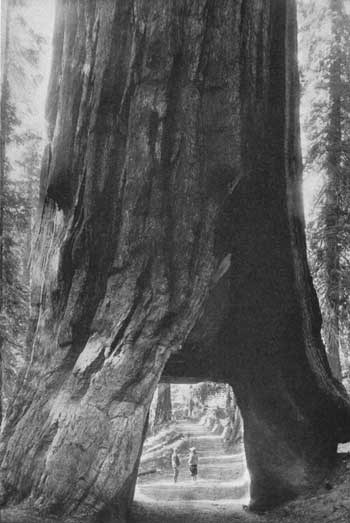
NPS Photo Where is the tree you can drive through?This question is asked thousands of times each year by visitors to Sequoia and Kings Canyon National Parks. They are surprised to hear that the famous tunneled sequoia tree they seek was never in these parks, but rather 100 air-miles north in the Mariposa Grove of Yosemite National Park. And to complicate matters further, this famous sequoia, the Wawona Tree, fell over in early 1969. The tunnel through Yosemite's famous Wawona Tree was cut in 1881 as a tourist attraction. It was the second standing sequoia to be tunneled (the first, a dead tree, still stands in the Tuolumne Grove in Yosemite). The Wawona Tree stood for 88 summers before it fell during the severe winter of 1968-69. Factors leading to its failure include heavy snow, wet soil, and, of course, the weakening effect of the tunnel. When it fell, the Wawona Tree was approximately 2,100 years old, 234 feet high (71.3 meters), and 26 feet in diameter at the base (7.9 meters). The famous tunnel was 7 feet wide, 9 feet high and 26 feet long at the base (2.1 meters by 2.7 meters by 7.9 meters). 
NPS Photo Sequoia National Park's Tunnel LogVisitors to Sequoia and Kings Canyon can drive through Sequoia Park's fallen "Tunnel Log" located along the Crescent Meadow Road in Giant Forest. The fallen Tunnel Log of Sequoia National Park came into being after an unnamed giant sequoia fell across the Crescent Meadow Road in late 1937 as a result of "natural causes." The following summer, a tunnel was cut through the fallen log as a visitor attraction. When it fell, the tree stood 275 feet high (83.8 meters) and was 21 feet in diameter at the base (6.4 meters). The tree's age when it fell has not been determined, but probably exceeded 2,000 years. The tunnel, which remains in use today, is 17 feet wide and 8 feet high (5.2 meters by 2.4 meters). There is a bypass for taller vehicles. "Why not cut a new tunnel tree?" many visitors suggest, when they discover that the Wawona Tree can no longer be driven through. Times change, however, and actions proper for one generation may not fit the needs and goals of a succeeding generation. Our expectations of national parks have changed immensely during the past half century. When our national parks were young, cutting tunnels through sequoia trees was a way to popularize the parks and gain support for their protection. In those early days, national parks usually were managed to protect individual features rather than to protect the integrity of the complete environment. Today, we realize that our national parks represent some of the last primeval landscapes in America, and our goal in the parks is to allow nature to run its course with as little interference from humans as possible. Tunnel trees had their time and place in the early history of our national parks. But today sequoias which are standing healthy and whole are worth far more. |
Last updated: August 9, 2023
